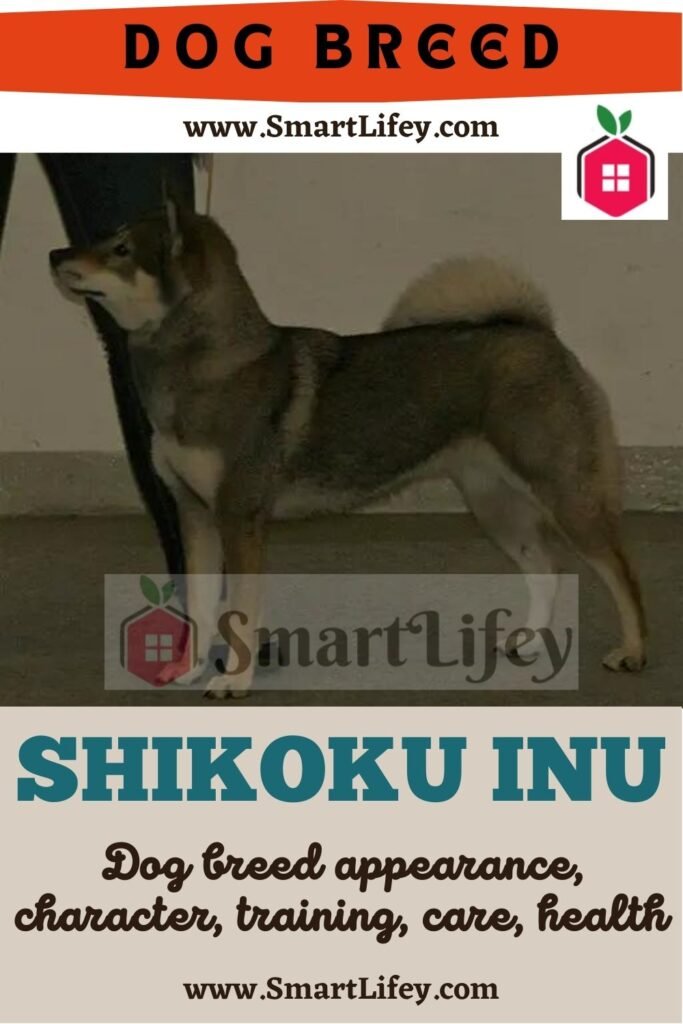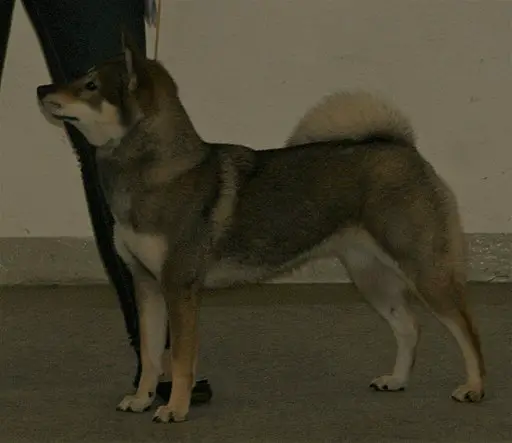
The Shikoku Inu is a Japanese dog found within the Spitz. This, along with other similar races is part of the oldest in the world.
However, Shikoku Inu are not very popular dogs inside or outside of Japan, so very little is known about them compared to other breeds.Therefore, here we will see all the information about this breed, its origin, characteristics, variants, care, character and much more.
Origin of the Shikoku Inu
Perhaps the name reveals the origin of this breed, these dogs are of Japanese origin. They were created in the mountainous region of Kochi, because of this, they used to have the name “Kochi Ken”.
Within this region, these dogs are very important and popular, in fact, the breed as such was declared a national monument in 1937 . The pattern for these dogs was developed by the International Cynological Federation in 2016. However, the Shikoku Inu were actually recognized since 1982.
Shikoku Inu Characteristics
This is a medium-sized breed, its weight can range between 15 and 20 kilograms. Regarding their height, males can measure between 49 and 55 centimeters, while females are between 46 and 52 cm. Their life expectancy can reach 10 or 12 years.
Now, in terms of their physical shape, the body of these dogs is very well proportioned, the lines are perfectly elegant, with a broad chest of good depth, which contrasts with their tucked-up belly.
The tail of these dogs is set high, is thick and can be seen curled up. It has quite developed and strong limbs and muscles; in addition to that, he has a slight inclination in his body.
The head of this breed is relatively large compared to its body, broad forehead and long, wedged-shaped muzzle. Their ears are small, triangular in shape and are always in an upright position with a slight inclination towards the front.
The eyes of these dogs are slightly triangular, due to the fact that they have a slanted angle from the outside to the top. They are medium in size and usually always have a dark brown hue.
The coat is quite dense and has a well structured bilayer, the lower layer is considered woolly, soft and denser than the upper one. The top layer has a much longer length and a slightly stiffer texture.
This type of coat makes the dog thermally protected during changes in temperature, especially during winter, when temperatures are quite low and, in some cases, extreme.
Breed colors
The most common is the sesame color, this is a combination of red, white and black colors. Depending on the predominant color within this combination, its variety can be categorized as follows:
- Sesame: when the predominant ones are both black and white.
- Red sesame: in this case, the predominant color or base color is red, while some scattered black and white hairs are observed throughout its body.
- Black sesame: here the predominant color is black, while white remains a recessive color.
Variants
The Shikoku Inu dog has three variants of the breed. These have some characteristics that make them different from each other:
Awa
This variety ceased to exist after the Second World War, so there is no information about it beyond that they were solid-bodied dogs but that they were not as robust as that of the Hata.
Hata
This is one of the two variants that are still in existence, it stands out for having a much more robust, wide and solid body. They are imposing dogs and with characteristics a bit far from the standard breed of the Shikoku.
Hongawa
This last variety is also currently in existence, it is considered to be the most faithful variety to the breed standard, this in terms of its physical appearance.
In addition, it is considered the purest variety of the three, this is because its place of origin is located in a distant and remote area. So the dogs were crossed between their own breed and there was not as much variability.
These are more stylized, elegant dogs with a lighter body. It could be said that this is the most popular and sought-after variety by lovers of the breed, as it fulfills more of the required characteristics.
Care
Because the coat of these dogs is dense and has a prominent bilayer, they will need to be brushed at least 2-3 times a week. This way you can ensure that your dog is free of dead hair, dirt and accumulated dust.
In addition to this, this is one of the best ways in which you can verify that your pet does not have external parasites, such as fleas or ticks attached to your pet’s fur or skin.
On the other hand, this breed will require daily exercise, in fact it will be necessary for the intensity to be between moderate and intense. In this way, the dog can have good balance and health.
Some options that we can take into account, in addition to daily walks, are activities or sports specially designed for canines, such as agility or resistance circuits.
You can also choose to have your dog accompany you to hiking or running activities, as these are activities that require a greater use of energy, so they are beneficial for these dogs.
Something that you should also take care of is the diet, it must be of high quality and adapt to the style of physical activity that the dog performs. Another important aspect that should be paid attention to are mental stimuli, this can be encouraged with intelligence games.
Shikoku Inu education
Because the Shikoku Inu race possesses a strong character, many believe that training is an impossible task. But this is not the case, they are very intelligent dogs, so if it is done in the right way, the training will be surprisingly effective, in fact, they will learn quickly.
They are fast learning dogs, as long as it is done correctly, this is because they have high intelligence and are persevering. What they do not understand well, they will do as many times as necessary until they receive the corresponding positive stimulus.
Something that we must always bear in mind and that happens with any breed of dog, is that the animal should not be punished or treated aggressively, as this could cause misbehavior.
For these dogs, none of these options is viable in education or training, as this will cause them to move away and be suspicious instead of being noticeable. What is going to cause that trust is lost and the bond that has been created with the animal is completely annulled.
The consequence that the bond that is made between the dog and the handler breaks, is that the animal will stop trusting it and therefore, will stop learning. They are stubborn dogs, so once you lose interest or confidence in something, it will be difficult to get it back.
Something important when it comes to educating is that within the family you must agree with the household rules, as they must coincide with each other to avoid confusing the animal.
When training begins, it should be done in a short but repetitive way during the day, this way you will not get bored and you will be able to stay alert.
Shikoku Inu character
The Shikoku Inu is a strong-willed dog, however, it is considered a benevolent dog. They were trained to be hunters and guardians, so they often have a great attention span and are always alert.
They are dogs of great cunning and high activity. This breed is active and very energetic, which is why they are not recommended for seniors or those who prefer to have a quiet life. They are also not recommended for those who live in small apartments.
These dogs need to have constant physical activity at all hours, therefore, they are considered tireless dogs, since it seems that they never exhaust their energy.
His behavior towards others is cautious and suspicious, especially with strangers, so he tends to show a cold and distant personality with these people, which sometimes resembles fear. For this reason, some dogs respond aggressively if they think they are having an attack.
They are not assertive in living with other animals, whether or not they are of the same species, so it is preferable to have them alone. The Shikoku Inu is a dominant dog, so there can be fights with other dogs if they live in the same space, especially if both are male.
Despite their character, they are faithful dogs and dedicated to their humans. Although they can also become independent, they always show in their own way that they love their own and that they are capable of anything to keep them safe.
They are ideal as companion dogs, especially during walks and physical activities, however, they prefer to have their own space. Due to this way of being, many believe that they are cold dogs, but in reality they adore their owners and protect them.
Diseases and Health
This is a healthy breed. The most common problems seen in these dogs are due to their dense coat, which is not very compatible in hot or hot climates. When they are exposed to very high temperatures they tend to suffer from heat stroke.
The other most common diseases in this breed are congenital, these can be:
- Hip dysplasia
- Patellar luxation
These are very common in these dogs because of their size. On the other hand, these types of diseases can also be due to the performance of the intense exercises that these dogs need. Since they can sometimes result in gastric torsion, which if not treated could be fatal.
Some other conditions are:
- Hypothyroidism
- Progressive retinal atrophy
These pathologies can be detected by making regular visits to the vet. In addition, in this way, the dog will receive its relevant check-ups, vaccinations and deworming that are of vital importance.
10 curiosities of the Shikoku Inu

- They are very old dogs, however they are not very well known (even within Japan) so there is not much data about them.
- There were 3 varieties of this breed: Hata, Awa, Hongawa. Of which, only the Hata and Hongawa are still alive.
- The most common color of its coat is sesame, and it is subdivided into 2 more varieties: red sesame and black sesame.
- They are extremely intelligent dogs, so training and educating them will be easy, since they will learn quickly. However, having a strong character, correct strategies must be used so that this can be achieved satisfactorily.
- It is an extremely energetic breed, so they require a high intensity of exercises. Therefore, it is recommended that these dogs have several daily walks and perform physical activities of wear and tear.
- They are faithful, loyal, loving and protective of their owners and family, however they like to be independent, so they should be given their space so that they can have time with themselves.
- They are very healthy dogs, however they can have problems in hot climates.
- They are not good at interacting with strangers, so they can show aggressive or distant behaviours.
- Being so active dogs, they are not recommended for older people or those who have low physical activity.
- The food provided should be appropriate to the dog’s lifestyle and the amount of physical activity it performs.
